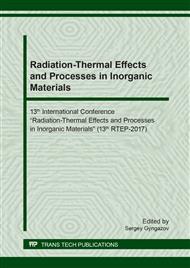p.165
p.170
p.176
p.185
p.190
p.195
p.200
p.206
p.211
The Effectiveness of Sulfotozifan in the Case of External Gamma Irradiation
Abstract:
No radiation protection agents have been found to date which would not have toxic side effects while having radioprotective action of unlimited duration. Based on the screening of organo-element chemical compounds, a novel radioprotector sulfotozifan was selected to prevent the acute radiation syndrome in animals. Sulfotozifan belongs to compounds of hazard class 3 (National Standard of the Russian Federation (GOST) 12.1:007.76). A single subcutaneous administration of sulfotozifan at a dose of 38.0 mg / kg of body weight 2-4 days prior to the radiation exposure of animals to an absolute lethal dose, protects 80-100% of the animals from the radiation death. The pretreatment of animals with sulfotozifan 2-4 days prior to the irradiation has a positive effect on the animals’ clinical condition, normalizes their hematological parameters, increases the levels of T and B lymphocytes, inhibits peroxidation of lipids (POL), reduces the concentration of malondialdehyde (MDA), the final product of POL, in the erythrocyte hemolysate and blood plasma, and also promotes a reduction in the formation of radiotoxins. By its organoleptic, physicochemical, and bacterioscopic characteristics, the meat from irradiated animals pretreated with sulfotozifan does not differ significantly from those of the meat from the control animals and thus meets GOST requirements.
Info:
Periodical:
Pages:
206-210
Citation:
Online since:
September 2018
Keywords:
Price:
Сopyright:
© 2018 Trans Tech Publications Ltd. All Rights Reserved
Share:
Citation:


